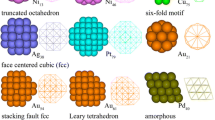Abstract
This study investigated the structural and electronic properties of (CuSn)n clusters with n = 1–6 using ab initio Monte Carlo Simulations and density functional theory calculations. Monte Carlo simulations were performed using a large number of initial structures of neutral, cationic, and anionic copper-tin clusters. Their stable structures were determined using B3LYP/def2-TZVP model chemistry and the most stable structures of neutral, cationic, and anionic copper-tin clusters were established. The values of bond angles and bond lengths, atomization energies, second differences of the energies, HOMO-LUMO gaps, Mulliken population analysis, adiabatic ionization potentials, and adiabatic electronic affinities were determined as a function of n.






Similar content being viewed by others
Data Availability
All data are fully available.
References
Bae G-T (2019) Density functional theory calculations of geometrical and electronic properties of neutral and charged silicon oxide clusters. Bull Kor Chem Soc 40:780–786
Bae G-T (2016) Structures and electronic properties of Cu3On (n = 1–6) clusters using ab initio Monte Carlo simulations. Bull Kor Chem Soc 37:638-642
Bae G-T, Dellinger B, Hall RW (2011) Density functional calculation of the structure and electronic properties of CunOn (n = 1-8) clusters. J Phys Chem A 115:2087–2095
Breaux GA, Hillman DA, Neal CM, Jarrold MF (2005) Stable copper−tin cluster compositions from high-temperature annealing. J Phys Chem A 109:8755–8759
Carrera A, Cristina LJ, Bengió S, Cossaro A, Verdini A, Floreano L, Fuhr JD, Gayone JE, Ascolani H (2013) Controlling carboxyl deprotonation on Cu(001) by surface Sn alloying. J Phys Chem C 117:17058–17065
Chen X, Henckel DA, Nwabara UO, Li Y, Frenkel AI, Fister TT, Kenis PJA, Gewirth AA (2020) Controlling speciation during CO2 reduction on Cu-Alloy electrodes. ACS Catal 10:672–682
Frisch MJ, Trucks GW, Schlegel HB, Scuseria GE, Robb MA, Cheeseman JR, Scalmani G, Barone V, Mennucci B, Petersson GA, Nakatsuji H, Caricato M, Li X, Hratchian HP, Izmaylov AF, Bloino J, Zheng G, Sonnenberg JL, Hada M, Ehara M, Toyota K, Fukuda R, Hasegawa J, Ishida M, Nakajima T, Honda Y, Kitao O, Nakai H, Vreven T, Montgomery Jr JA, Peralta JE, Ogliaro F, Bearpark MJ, Heyd J, Brothers EN, Kudin KN, Staroverov VN, Kobayashi R, Normand J, Raghavachari K, Rendell AP, Burant JC, Iyengar SS, Tomasi J, Cossi M, Rega N, Millam NJ, Klene M, Knox JE, Cross JB, Bakken V, Adamo C, Jaramillo J, Gomperts R, Stratmann RE, Yazyev O, Austin AJ, Cammi R, Pomelli C, Ochterski JW, Martin RL, Morokuma K, Zakrzewski VG, Voth GA, Salvador P, Dannenberg JJ, Dapprich S, Daniels AD, Farkas Ö, Foresman JB, Ortiz JV, Cioslowski J, Fox DJ (2009) Gaussian 09. Gaussian, Inc., Wallingford, CT, USA
Hou J, Sun J, Zhan C, Tian X, Chen X (2007) The structural change of Cu-Sn melt. Sci. China Ser. G: Physics. Mechanics and Astronomy 50:414–420
Lee J-H, Yun J, Lee T, Soon A (2017) Ab initio surface phase diagram of Sn/Cu(001): reconciling experiments with theory. Phys Rev Appl 8:034010
Li Q, Fu J, Zhu W, Chen Z, Shen B, Wu L, Xi Z, Wang T, Lu G, Zhu J-J, Sun S (2017) Tuning Sn-catalysis for electrochemical reduction of CO2 to CO via the core/shell Cu/SnO2 structure. J Am Chem Soc 139:4290–4293
Morimoto M, Takatsuji Y, Yamasaki R, Hashimoto H, Nakata I, Sakakura T, Haruyama T (2018) Electrodeposited Cu-Sn alloy for electrochemical CO2 reduction To CO/HCOO-. Electrocatalysis 9:323-332
Sarfraz S, Garcia-Esparza AT, Jedidi A, Cavallo L, Takanabe K (2016) Cu–Sn bimetallic catalyst for selective aqueous electroreduction of CO2 to CO. ACS Catal 6:2842–2851
Scharfe S, Fässler TF, Stegmaier S, Hoffmann SD, Ruhland K (2008) [Cu@Sn9]3− and [Cu@Pb9]3−: intermetalloid clusters with endohedral Cu atoms in spherical environments. Chem.-Eur. J. 14:4479–4483
Tan M, Xiufang B, Xianying X, Yanning Z, Jing G, Baoan S (2007) Correlation between viscosity of molten Cu–Sn alloys and phase diagram. Phys B Condens Matter 387:1–5
Wang J, Ji Y, Shao Q, Yin R, Guo J, Li Y, Huang X (2019) Phase and structure modulating of bimetallic CuSn nanowires boosts electrocatalytic conversion of CO2. Nano Energy 59:138–145
Weigend F, Ahlrichs R (2005) Balanced basis sets of split valence, triple zeta valence and quadruple zeta valence quality for H to Rn: design and assessment of accuracy. Phys Chem Chem Phys 7:3297–3305
Funding
This work was supported by the National Research Foundation of Korea (NRF) grant funded by the Korean government (MSIT)(NRF-2018R1D1A1B07042931).
Author information
Authors and Affiliations
Contributions
GT Bae was responsible for the overall investigations.
Corresponding author
Ethics declarations
Ethics approval
Ethics approval and consent to participate.
Consent for publication
GT Bae has agreed to submit.
Conflict of interest
The author declares no competing interests.
Additional information
Publisher’s note
Springer Nature remains neutral with regard to jurisdictional claims in published maps and institutional affiliations.
Rights and permissions
About this article
Cite this article
Bae, GT. Ab initio Monte Carlo simulations of structure and electronic properties of copper-tin clusters. Struct Chem 32, 1787–1794 (2021). https://doi.org/10.1007/s11224-021-01747-5
Received:
Accepted:
Published:
Issue Date:
DOI: https://doi.org/10.1007/s11224-021-01747-5




